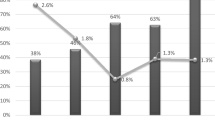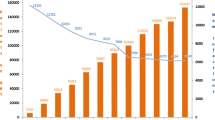Abstract
Joint United Nations Programme on HIV/AIDS (UNAIDS) established 90–90–90 HIV treatment targets for 2020 including the following: 90 % of HIV-infected people know their HIV status, 90 % of HIV-infected people who know their status are on treatment, and 90 % of people on HIV treatment have a suppressed viral load. Integration of HIV and other programs into the national health system provides an important pathway to reach those targets. We examine the case for integrating HIV and other health services to ensure sustainability and improve health outcomes within national health systems. In this non-systematic review, we examined recent studies on integrating HIV, tuberculosis (TB), maternal-child health (MCH), and sexually transmitted infection (STI) programs. Existing evidence is limited about the effectiveness of integration of HIV and other services. Most studies found that service integration increased uptake of services, but evidence is mixed about the effect on health outcomes or quality of health services. More rigorous studies of different strategies to promote integration over a wider range of services and settings are needed. Research on how best to maximize benefits, including sustainability, of integrated services is necessary to help inform international and national policy. We recommend additional interventions to test how best to integrate HIV and MCH services, HIV and TB services, HIV testing and treatment, and STI testing and treatment.
Similar content being viewed by others
References
Papers of particular interest, published recently, have been highlighted as: •• Of major importance
UNAIDS, 2014. “90–90–90—an ambitious treatment target to help end the AIDS epidemic” Accessed January 17, 2016. http://www.unaids.org/en/resources/documents/2014/90-90-90
Schneider H, Blaauw D, Gilson L, Chabikuli N, Goudge J. Health systems and access to antiretroviral drugs for HIV in Southern Africa: service delivery and human resources challenges. Reprod Health Matters. 2006;14:12–23.
England R. The dangers of disease specific aid programmes. BMJ. 2007;335:565.
Garrett L. The challenge of global health. http://www.foreignaffairs.org/20070101faessay86103-po/laurie-garrett/thechallenge-of-global-health.html. Foreign Affairs 2007.
Jack A. From symptom to system. Financial Times 2007, 28 Sept.
Piller C, Smith D. Unintended victims of gates foundation generosity. Los Angeles Times. 2007, 16 Dec.
Haines A, Haines A. Editorial: contribution of health systems to disease control. Trop Med Int Health. 2007;12(11):1275–8.
England R. The writing is on the wall for UNAIDS. BMJ. 2008;336:1072.
Ooms G, Van Damme W, Baker BK, Zeitz P, Schrecker T. The ‘diagonal’ approach to Global Fund financing: a cure for the broader malaise of health systems? Glob Health. 2008;4:6. doi:10.1186/1744-8603-4-6.
Bendavid E, Bhattacharya J. The president’s emergency plan for AIDS relief in Africa: an evaluation of outcomes. Ann Intern Med. 2009;150(10):688–95.
Bendavid E, Holmes CB, Bhattacharya J, Miller G. HIV development assistance and adult mortality in Africa. JAMA. 2012;307(19):2060–7. doi:10.1001/jama.2012.2001.
Duber HC, Coates TJ, Szekeras G, Kaji AH, Lewis RJ. Is there an association between PEPFAR funding and improvement in national health indicators in Africa? A retrospective study. J Int AIDS Soc. 2010;13:21. doi:10.1186/1758-2652-13-21.
Rabie H, Frigati L, Hesseling AC, Garcia-Prats AJ. Tuberculosis: opportunities and challenges for the 90-90-90 targets in HIV-infected children. J Int AIDS Soc. 2015;18(7 Suppl 6):20236. doi:10.7448/IAS.18.7.20236. The article documents opportunities and challenges for 90-90-90 targets in HIV infected children with TB. Up to 57% of children diagnosed with TB are also HIV infected. TB results in substantial morbidity and mortality. Prevention can be achieved by increasing access to ART for adults and children, and isoniazid preventative therapy. However, authors noted the complications in co-treatment of HIV and TB because of drug interactions. Specific attention to TB care in HIV infected children is needed to enhance care and achieve 90-90-90 goals.
Scott V, Chopra M, Azevedo V, Caldwell J, Naidoo P, Smuts B. Scaling up integration: development and results of a participatory assessment of HIV/TB services, South Africa. Health Res Policy Syst. 2010;8:23. doi:10.1186/1478-4505-8-23.
Scott VE, Sanders D. Evaluation of how integrated HIV and TB programs are implemented in South Africa and the implications for rural-urban equity. Rural Remote Health. 2013;13(2):2165.
Balira R, Mabey D, Weiss H, Ross DA, Changalucha J, Watson-Jones D. The need for further integration of services to prevent mother-to-child transmission of HIV and syphilis in Mwanza City, Tanzania. Int J Gynaecol Obstet. 2015;130 Suppl 1:S51–7. doi:10.1016/j.ijgo.2015.04.016.
Washington S, Owuor K, Turan JM, Steinfeld RL, Onono M, Shade SB, et al. Implementation and operational research: effect of integration of HIV care and treatment into antenatal care clinics on mother-to-child HIV transmission and maternal outcomes in Nyanza, Kenya: results from the SHAIP cluster randomized controlled trial. J Acquir Immune Defic Syndr. 2015;69(5):e164–71. doi:10.1097/QAI.0000000000000656.
Myer L, Carter RJ, Katyal M, Toro P, El-Sadr WM, Abrams EJ. Impact of antiretroviral therapy on incidence of pregnancy among HIV-infected women in Sub-Saharan Africa: a cohort study. PLoS Med. 2010;7(2):e1000229. doi:10.1371/journal.pmed.1000229.
An SJ, George AS, LeFevre A, Mpembeni R, Mosha I, Mohan D, et al. Program synergies and social relations: implications of integrating HIV testing and counselling into maternal health care on care seeking. BMC Public Health. 2015;15:24. doi:10.1186/s12889-014-1336-3.
Birdthistle IJ, Mayhew SH, Kikuvi J, Zhou W, Church K, Warren CE, et al. Integra Initiative. Integration of HIV and maternal healthcare in a high HIV-prevalence setting: analysis of client flow data over time in Swaziland. BMJ Open. 2014;4(3):e003715. doi:10.1136/bmjopen-2013-003715.
Odafe S, Torpey K, Khamofu H, Oladele E, Adedokun O, Chabikuli O, et al. Integrating cervical cancer screening with HIV care in a district hospital in Abuja. Nigeria Niger Med J. 2013;54(3):176–84. doi:10.4103/0300-1652.114590.
Baker U, Okuga M, Waiswa P, Manzi F, Peterson S, Hanson C, et al. Bottlenecks in the implementation of essential screening tests in antenatal care: syphilis, HIV, and anemia testing in rural Tanzania and Uganda. Int J Gynaecol Obstet. 2015;130(1):S43–50. doi:10.1016/j.ijgo.2015.04.017.
Lindegren ML, Kennedy CE, Bain-Brickley D, Azman H, Creanga AA, Butler LM, et al. Integration of HIV/AIDS services with maternal, neonatal and child health, nutrition, and family planning services. Cochrane Database Syst Rev. 2012;9:CD010119. doi:10.1002/14651858.CD010119.
Kimani J, Warren CE, Abuya T, Ndwiga C, Mayhew S, Vassall A, et al. Use of HIV counseling and testing and family planning services among postpartum women in Kenya: a multicentre, non-randomised trial. BMC Womens Health. 2015;15(1):104. doi:10.1186/s12905-015-0262-6.
Edwards JK, Bygrave H, Van den Bergh R, Kizito W, Cheti E, Kosgei RJ, et al. HIV with non-communicable diseases in primary care in Kibera, Nairobi, Kenya: characteristics and outcomes 2010-2013. Trans R Soc Trop Med Hyg. 2015;109(7):440–6. doi:10.1093/trstmh/trv038.
WHO, “Integration of health services: where and why?” Technical Brief No.1, 2008.
Berwick DM, Nolan TW, Whittington J. The triple aim: care, health, and cost. Health Aff. 2008;27(3):759–69. doi:10.1377/hlthaff.27.3.759.
Kodner DL. All together now: a conceptual exploration of integrated care. Healthc Q. 2009;13:6–15. doi:10.12927/hcq.2009.21091.
World Health Organization. The world health report 2008: primary health care—now more than ever. Geneva: World Health Organization; 2008.
Republic of Botswana, Ministry of Health. “Integrated health service plan: a strategy for changing the health sector for healthy Botswana, 2010-2020.” November, 2010.
Dudley L, Garner P. Strategies for integrating primary health services in low- and middle-income countries at the point of delivery. Cochrane Database Syst Rev. 2011;7:CD003318. doi:10.1002/14651858.CD003318.pub3.
Killam WP, Tambatamba BC, Chintu N, Rouse D, Stringer E, Bweupe M, et al. Antiretroviral therapy in antenatal care to increase treatment initiation in HIV-infected pregnant women: a stepped-wedge evaluation. AIDS. 2010;24(1):85–91. doi:10.1097/QAD.0b013e32833298be.
http://www.pepfar.gov/countries/tanzania/index.htm. Accessed January 23, 2016.
Bristow CC, Leon SR, Ramos LB, Vargas SK, Flores JA, Konda KA, et al. Laboratory evaluation of a dual rapid immunodiagnostic test for HIV and syphilis infection. J Clin Microbiol. 2015;53(1):311–3. doi:10.1128/JCM.02763-14.
Gunn JK, Asaolu IO, Center KE, Gibson SJ, Wightman P, Ezeanolue EE, et al. Antenatal care and uptake of HIV testing among pregnant women in sub-Saharan Africa: a cross-sectional study. J Int AIDS Soc. 2016;19(1):20605.
Chamla DD, Essajee S, Young M, Kellerman S, Lovich R, Sugandhi N, et al. Integration of HIV in child survival platforms: a novel programmatic pathway towards the 90-90-90 targets. J Int AIDS Soc. 2015;18(7 Suppl 6):20250. doi:10.7448/IAS.18.7.20250. The article reports on novel programmatic pathways toward 90-90-90 targets including integration of HIV into child survival platforms. Authors describe the Double Dividend framework which is a new programmatic approach with dual goal of improving pediatric HIV care and child survival. In this commentary, authors discuss why integrating HIV testing, treatment and care is important to achieving 90-90-90 targets. Authors cite research which demonstrated that integration of HIV in programs such as immunization and nutrition has been associated with an increased uptake of HIV infant testing, and used for case-finding of HIV infected children using point of care diagnostics. The authors argue that there are still challenges to be addressed to maximize the benefits of integration for child survival and HIV care.
Wang PC, Mwango A, Moberley S, Brockman BJ, Connor AL, Kalesha-Masumbu P, et al. A cluster randomised trial on the impact of integrating early infant HIV diagnosis with the expanded programme on immunization on immunization and HIV testing rates in rural health facilities in Southern Zambia. PLoS One. 2015;10(10):e0141455. doi:10.1371/journal.pone.0141455.
Aliyu Muktar H, Blevins M, Audet C, Kalish M, Gebi U, Onwujekew O, et al. Integrated prevention of mother-to-child HIV transmission services, antiretroviral therapy initiation, and maternal and infant retention in care in rural north-central Nigeria: a cluster-randomised controlled trial. The Lancet HIV. In Press. Published online February 24, 2016.
Annual Performance Plan 2012/13–2014/15, Department of Health, South Africa 2012 Accessed April 18, 2016 http://www.tbfacts.org/tb-statistics-south-africa/#sthash.l97InpSV.dpuf.
World Health Organization, “Global Tuberculosis Report.” 2015 http://www.who.int/tb/publications/global_report/en/. Accessed January 23, 2016
Chehab JC, Vilakazi-Nhlapo AK, Vranken P, Peters A, Klausner JD. Current integration of tuberculosis (TB) and HIV services in South Africa, 2011. PLoS One. 2013;8(3):e57791. doi:10.1371/journal.pone.0057791.
Coggin WL, Ryan CA, Holmes CB. Role of the US president’s emergency plan for AIDS relief in responding to tuberculosis and HIV coinfection. Clin Infect Dis. 2010;50 Suppl 3:S255–9. doi:10.1086/651499.Review.58.
Lawn SD, Campbell L, Kaplan R, Boulle A, Cornell M, Kerschberger B, et al. Time to initiation of antiretroviral therapy among patients with HIV-associated tuberculosis in Cape Town, South Africa. J Acquir Immune Defic Syndr. 2011;57:136–40.
Lawn SD, Campbell L, Kaplan R, Little F, Morrow C, Wood R. Delays in starting antiretroviral therapy in patients with HIV-associated tuberculosis accessing non-integrated clinical services in a South African township. BMC Infect Dis. 2011;11:258.
Howard AA, El-Sadr WM. Integration of tuberculosis and HIV services in sub-Saharan Africa: lessons learned. Clin Infect Dis. 2010;50 Suppl 3:S238–44.
Legido-Quigley H, Montgomery CM, Khan P, Atun R, Fakoya A, Getahun H, et al. Integrating tuberculosis and HIV services in low- and middle-income countries: a systematic review. Trop Med Int Health. 2013;18(2):199–211. doi:10.1111/tmi.12029.
Author information
Authors and Affiliations
Corresponding author
Ethics declarations
Conflict of Interest
Dvora Joseph Davey, Landon Myer, Elizabeth Bukusi, Doreen Ramogola-Masire, William Kilembe, and Jeffrey D. Klausner declare that they have no conflict of interest.
Human and Animal Rights and Informed Consent
This article does not contain any studies with human or animal subjects performed by any of the authors.
Additional information
This article is part of the Topical Collection on The Global Epidemic
Rights and permissions
About this article
Cite this article
Joseph Davey, D., Myer, L., Bukusi, E. et al. Integrating Human Immunodeficiency Virus and Reproductive, Maternal and Child, and Tuberculosis Health Services Within National Health Systems. Curr HIV/AIDS Rep 13, 170–176 (2016). https://doi.org/10.1007/s11904-016-0316-x
Published:
Issue Date:
DOI: https://doi.org/10.1007/s11904-016-0316-x




